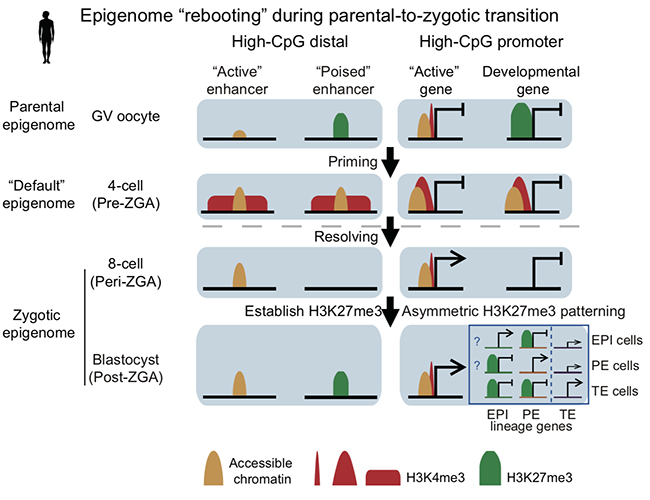Wei Xie’s group, Ying-pu Sun/Jiawei Xu’s group published research in Science on the reprogramming of histone modifications in human early development
A joint team led by Prof. Wei Xie at Tsinghua University and Prof. Ying-pu Sun/Jiawei Xu from the First Affiliated Hospital of Zhengzhou University, revealed how histone modifications are reprogrammed during human early development. Their findings are published in Science on July 4, 2019 as a research article entitled “Resetting histone modifications during human parental-to-zygotic transition”. This work not only uncovered unique states in parental-to-zygotic transition and early lineage segregation in human early embryos, but also demonstrated a highly species-specific mode of histone reprogramming in animal early development.
Epigenetic marks regulate gene expression and animal development. In mammalian early development, the oocyte fertilized by the sperm forms the totipotent zygote and develops to the blastocyst which contains pluripotent inner cell mass (ICM). Along such processes, the epigenetic marks undergo drastic reprogramming. In recent years, studies in mouse have revealed the principles of dynamics of DNA methylation, chromatin accessibility, high order chromatin structure as well as histone modifications during this development window. In particular, previous studies in Wei Xie’s lab and others have found that the histone modifications H3K4me3 and H3K27me3 exhibit non-canonical patterns in mouse mature oocytes, and can be briefly inherited into early embryos to regulate transcription and development. Defects in reprogramming of such non-canonical histone marks can lead to the developmental deficiency. However, how histone modifications are reprogrammed in human and whether their reprogramming shares the same principles as that in mouse remain elusive.
Wei Xie’s group first optimized CUT&RUN method to successfully profile histone modifications from as little as 50 cells. In collaboration with Drs. Ying-pu Sun/Jiawei Xu’s group, they profiled key histone modifications H3K4me3 and H3K27me3 in human oocytes and pre-implantation embryos as well as H3K27ac at selected stages. Surprisingly, they found that, unlike that in mouse, both H3K4me3 and H3K27me3 show canonical patterns in human oocytes similar as those in somatic cells. After fertilization, H3K27me3 undergoes a global depletion before ZGA, in contrast to mouse where H3K27me3 can be briefly preserved to the blastocyst. H3K27me3 is restored after ZGA and becomes readily detected in blastocyst. By contrast, H3K4me3 is pervasively deposited into many regulatory elements including promoters and distal enhancer-like regions after fertilization. Such pre-ZGA H3K4me3 highly correlates with CpG density and chromatin accessibility, and is thus termed as “priming H3K4me3”. After ZGA, these regulatory regions transit into either active or repressive states. The researchers proposed an epigenetic “rebooting” model during parental-to-zygotic transition. These data indicate distinct reprogramming modes for histone modifications among different species. By combing chromatin maps and published single-cell RNA-seq, the researchers also inferred the transcriptional circuity and master regulators in human early lineage segregation. Interestingly, the ICM (including epiblast and primitive endoderm) lineage genes but not trophectoderm lineage genes are preferentially marked by H3K27me3 in human early embryos. These data suggest an asymmetric epigenetic patterning during early lineage segregations. Collectively, these above results underscore the unique chromatin states in human early development. The divergence between human and mouse also highlights the importance of direct investigation in human rather than simple extrapolation from model organisms. The study will pave the way for further investigations of epigenetic reprogramming in human early development as well as related IVF researches.

Fig. The model of reprogramming of histone modifications in human early development
Prof. Wei Xie from School of Life Sciences at Tsinghua University, Prof. Ying-Pu Sun/Jiawei Xu from the First Affiliated Hospital of Zhengzhou University are the co-corresponding authors of this work. Weikun Xia (Ph.D. student from CLS program at Tsinghua University), Jiawei Xu (the First Affiliated Hospital of Zhengzhou University), Guang Yu (Ph.D. student from School of Life Sciences at Tsinghua University) and Guidong Yao (the First Affiliated Hospital of Zhengzhou University) are co-first authors of this work. Kai Xu (Ph.D. student from CLS at Peking University), Xueshan Ma (the First Affiliated Hospital of Zhengzhou University) and Nan Zhang (Ph.D. student from the First Affiliated Hospital of Zhengzhou University) also made important contributions to this study. This work was supported by the National Natural Science Foundation of China, Henan Provincial Obstetrical and Gynecological Diseases (Reproductive Medicine) Clinical Research Center, National Key R&D Program, National Basic Research Program of China, Beijing Municipal Science & Technology Commission and THU-PKU Center for Life Sciences. Prof. Wei Xie is also an HHMI International Research Scholar.
Full text link: https://science.sciencemag.org/content/early/2019/07/02/science.aaw5118
Source: School of Life Sciences
Editor: Guo Lili

